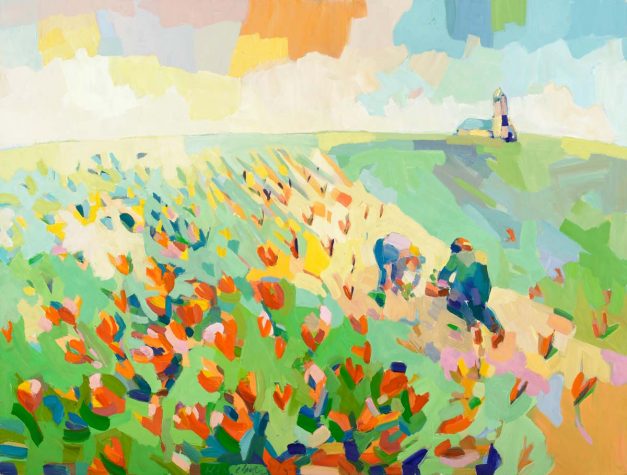Color Splash
At the height of summer, the world’s colors take on a brightness and saturation that match the vitality of the season. Taking inspiration from natural forms—from the microscopic to the grand—Henry Isaacs, Jodi Edwards, and Mary Barnes use those lively shades to spectacular effect.
Henry Isaacs
“Growing up, my parents’ home was filled with art,” says Isaacs, whose mother and father were both artists and had many friends in the New York and Boston art communities. He knew by high school that he wanted to pursue art as a career. Having had extensive exposure to various types of art and the art history of many disparate cultures, it is no surprise that Isaacs “cannot even begin to sort out my influences. I beg, borrow, and steal consciously and unconsciously.” But one significant influence has been his decades-long friendship with fellow artist Ashley Bryan. “At 93, he is doing his best painting ever,” says Isaacs. The two enjoy viewing and critiquing each other’s work and good-naturedly arguing about art. “It’s a very special relationship,” Isaacs says. “Despite years of college and grad school, and more years teaching, it is Ashley who has taught me the exuberance of a life in art, the thrill of color, and the spirit of painting.”
The majority of Isaacs’s work is commissioned, which allows him to develop relationships with clients. “Working directly with a client gives me the opportunity to collaborate in the creation of work,” he says. “There are wonderful assignments that I take on, trying to come up with a synthesis of the client’s ideas and my own.” Poppy Fields, Brittany is not a commissioned painting, but Isaacs was in France for another commission when he stumbled upon the scene that inspired it. He spent hours making oil studies, returning to them years later to start a larger painting on canvas. “The experience of those hours sitting in the field became instantly tangible again,” he says. Two figures are rendered in simple blocks of color, keeping the focus on the “gorgeous river of red flowers” that caught Isaacs’s attention on the day. The bright blossoms are drawn with angled brushstrokes, guiding the eye around the sweeping composition. Isaacs’s simplification of form, combined with his bold palette, conveys an evocative impression of his subject. One can almost smell the floral aromas in the warm summer air.
Jodi Edwards
An artist who paints with a high level of physicality, Edwards is hugely inspired by music. “It is such an integral part of my art,” she says. “I can’t paint without it.” With jazz, blues, or rock and roll playing, Edwards typically paints on her deck. “I feel like a conduit; the music is my muse, and somehow the paint flows through me easily and effortlessly,” she says. The verve that she puts into creating her art is evident in every stroke and splatter of paint. “I often get lost in the paint and the time, and it takes me somewhere,” she says. “I think I am happiest when I paint.” That joy is infectious: it is impossible to experience her art and not feel a jolt.
Painting in accordance with the seasons, her palette shifts from bright hues in the spring and summer to more subdued tones in the winter and fall. Summer Colors V is part of a series all done in the same sunny shades. Aqua blues dominate, while areas of golden yellow anchor the composition. Dashes of fiery red bring vigor and a sense of movement. Like jazz, the painting seems to be a creation of improvisation, but all of its elements work together in pure harmony.
Mary Barnes
As a child, Barnes spent much of her time exploring hidden spots in the woods and reveling in imaginative play. Regardless of the weather, she “found seclusion” in her bucolic domain. “My art today is about moments of observation, recent memories, and imagined places in the landscape,” she says. She says she imagines herself within her paintings all the time. Barnes uses the exercise as a way of critiquing her own work, asking herself if the world she has made within a painting is a captivating place to be. Part of what makes her art so fascinating is the tension between reality and abstraction. “I sit on that fence, pull from both sides, and ask the viewer to go on a journey,” she says.
Following an intuitive process, Barnes doesn’t start a painting with an idea of what the finished product will look like. In Origins she wanted to find “ways to draw with the paint and freely approach the canvas.” Beginning with an irregular circle, she let the painting unfold from there, soon recognizing a “biological” element in the work that inspired its title. The off-kilter ovoid shapes call to mind particles seen under a microscope or collected in petri dishes. But Origins possesses a harmony of color that creates a more inviting atmosphere. Golden yellows, deep orange, and bold red are tempered by touches of pale blue. Trained in abstract expressionism, Barnes notes that “the presence of my hand is key.” The artist’s free-flowing brushwork imbues Origins with a personal touch, further adding to the painting’s sense of warmth.





